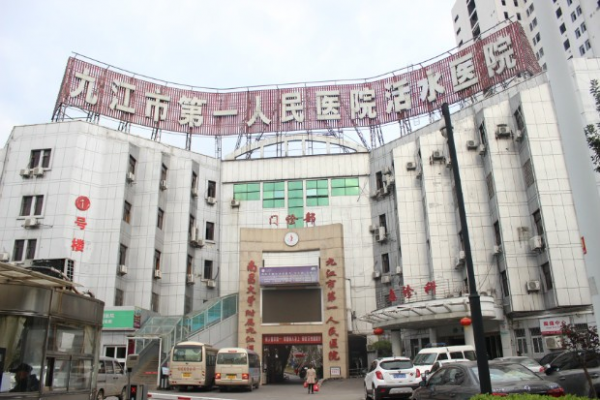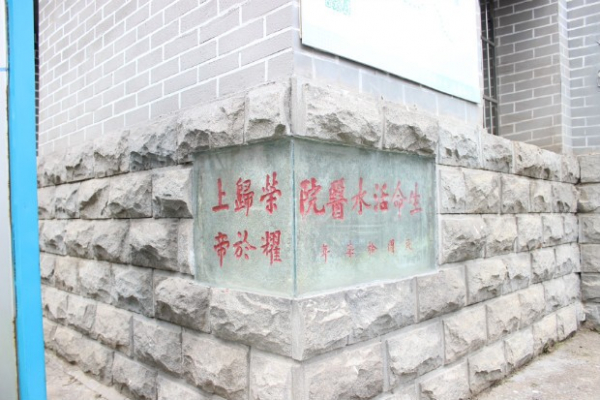As one of the five river-line cities in China, Jiujiang was once a place opened as a treaty port where foreign missionaries from different denominations gathered, running hospitals and schools that cultivated new preachers.
However, very little of the church property has been preserved after a century. The government took over the schools and hospitals. Many old priest houses and churches disappeared during the transformation of the old city.

Jiujiang City First People's Hospital
Currently, apart from an old church in the city, Jiujiang First People's Hospital is marked as one of the few legacies left by the missionaries, with a cornerstone on which it reads, "Glory to God". Built in 1893, the hospital was formerly named "Living Water Hospital" by the American church. The bulletin inside the hospital introduces its past history:

The cornerstone on which reads, "Glory to God" and “hospital of water of life.”
"In 1867, two Methodist Episcopal missionaries, Mr. Harley and Mr. Tauly, came to Jiujiang from Fuzhou. They established a church and the Empty Port (Bulang) primary school by Shiqiao Ko outside the city, an area that corresponds to PengPu road of the present day. In 1893, the missionaries opened a clinic next to the primary school and named it "Living Water", meaning that the clinic was a place where the water of life continued. Another Methodist Episcopal missionary, Edward Carter Perkins, came to Jiujiang in 1915. Under the direction of Dr. Perkins, the clinic expanded into the Water of Life Building. According to historical records, Mr. Sun Yat-sen inscribed the name of the building.
"In the spring of 1927, during a fundraising land auction by the Jiujiang Municipal Government, the hospital purchased an area near South Taling Road (current location of the hospital) for hospital renovation. The foundation laying ceremony of the new Living Water hospital was held on the afternoon of July 7th 1927, and the construction was completed by the end of the same year. The four floored colonial style building appeared in a "U" shape, and the surrounding garden was planted in the shape of "S". From an aerial viewpoint, the entire complex comprised the word "US". Under the canopy of the ancient camphor trees, the European style structure of the hospital comfortably stood. Together, they represented the harmonious encounter of the West with the East. At the time, the hospital had 80 beds and multiple divisions, including medical department, surgical department, ophthalmology department, the laboratory as well as the operation room.
"As a witness to the revolutionary changes of the past century, Water of Life Building was designated as a municipal heritage conservation site in 1991. The local government constructed a musical foundation square with an area of 3400 m2 (or 0.84 acre) in the hospital. The building has developed into a modern, garden style comprehensive hospital specializing in patient care, treatment, teaching, rehabilitation and clinic research."
Translated by Karen Luo
As one of the five river-line cities in China, Jiujiang was once a place opened as a treaty port where foreign missionaries from different denominations gathered, running hospitals and schools that cultivated new preachers.
However, very little of the church property has been preserved after a century. The government took over the schools and hospitals. Many old priest houses and churches disappeared during the transformation of the old city.

Jiujiang City First People's Hospital
Currently, apart from an old church in the city, Jiujiang First People's Hospital is marked as one of the few legacies left by the missionaries, with a cornerstone on which it reads, "Glory to God". Built in 1893, the hospital was formerly named "Living Water Hospital" by the American church. The bulletin inside the hospital introduces its past history:

The cornerstone on which reads, "Glory to God" and “hospital of water of life.”
"In 1867, two Methodist Episcopal missionaries, Mr. Harley and Mr. Tauly, came to Jiujiang from Fuzhou. They established a church and the Empty Port (Bulang) primary school by Shiqiao Ko outside the city, an area that corresponds to PengPu road of the present day. In 1893, the missionaries opened a clinic next to the primary school and named it "Living Water", meaning that the clinic was a place where the water of life continued. Another Methodist Episcopal missionary, Edward Carter Perkins, came to Jiujiang in 1915. Under the direction of Dr. Perkins, the clinic expanded into the Water of Life Building. According to historical records, Mr. Sun Yat-sen inscribed the name of the building.
"In the spring of 1927, during a fundraising land auction by the Jiujiang Municipal Government, the hospital purchased an area near South Taling Road (current location of the hospital) for hospital renovation. The foundation laying ceremony of the new Living Water hospital was held on the afternoon of July 7th 1927, and the construction was completed by the end of the same year. The four floored colonial style building appeared in a "U" shape, and the surrounding garden was planted in the shape of "S". From an aerial viewpoint, the entire complex comprised the word "US". Under the canopy of the ancient camphor trees, the European style structure of the hospital comfortably stood. Together, they represented the harmonious encounter of the West with the East. At the time, the hospital had 80 beds and multiple divisions, including medical department, surgical department, ophthalmology department, the laboratory as well as the operation room.
"As a witness to the revolutionary changes of the past century, Water of Life Building was designated as a municipal heritage conservation site in 1991. The local government constructed a musical foundation square with an area of 3400 m2 (or 0.84 acre) in the hospital. The building has developed into a modern, garden style comprehensive hospital specializing in patient care, treatment, teaching, rehabilitation and clinic research."
Translated by Karen Luo









